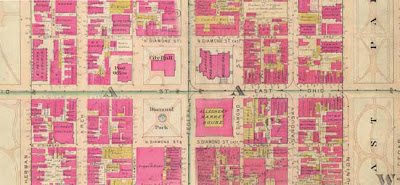Now everyone knows that the British chased the French out of the region between the Allegheny and Monongahela rivers to establish the settlement in 1758. The Diamond officially took shape 20 years later when the Penn family surveyed the land nearby their manor home at Ft. Pitt at the Point. In a big time act of generosity, the Penns signed over to the city the deed to the land so that it could be put to good use as a social, civic and merchants' gathering spot. At its four corners, the Diamond pointed north, south, east and west and served as a compass for visitors who enjoyed the taverns and inns around the Diamond. Kind of sounds familiar, doesn't it?
 While the British settled the area, the Diamond bears strong traces of our City's heavy Scotch-Irish heritage. Even today, one of the streets leading to the Square is called McMasters Way. And it turns out that Diamonds can still be found throughout the northern area of the Emerald Isle in places such as Rapahoe, Clones and a town called Donegal, which just happens to have a counterpart here in Western Pennsylvania. Donegal's Diamond is pictured above, used just as Pittsburgh's was before the court house and market was built. In Architectural Heritage of Western Pennsylvania, Charles Stotz writes, "Public squares or "Diamonds" were common in many early American towns, intended as 'practical provisions for the overnight parking of coaches, wagons, and horses rather than for beautification . . . [and as] social centers for towns.'" And just across the Allegheny River, the land that sits in front of the former Buhl Science Center — now part of the wonderful Children's Museum — was a grassy expanse known as Diamond Park. Back then, it was the center of Allegheny City and just across the street from its very own Market House. Seems that Diamonds and Market Houses made good partners.
While the British settled the area, the Diamond bears strong traces of our City's heavy Scotch-Irish heritage. Even today, one of the streets leading to the Square is called McMasters Way. And it turns out that Diamonds can still be found throughout the northern area of the Emerald Isle in places such as Rapahoe, Clones and a town called Donegal, which just happens to have a counterpart here in Western Pennsylvania. Donegal's Diamond is pictured above, used just as Pittsburgh's was before the court house and market was built. In Architectural Heritage of Western Pennsylvania, Charles Stotz writes, "Public squares or "Diamonds" were common in many early American towns, intended as 'practical provisions for the overnight parking of coaches, wagons, and horses rather than for beautification . . . [and as] social centers for towns.'" And just across the Allegheny River, the land that sits in front of the former Buhl Science Center — now part of the wonderful Children's Museum — was a grassy expanse known as Diamond Park. Back then, it was the center of Allegheny City and just across the street from its very own Market House. Seems that Diamonds and Market Houses made good partners.
 Well, very soon, diamonds will sparkle again in the Square thanks to artist Carin Mincemoyer, whose installation of 8-inch tall Plexiglas "diamonds" will accessorize lamp posts at the entrance of the Square. At night, LED lights will make the diamonds glitter and glow as people pass below to dine in the Square or just spend some time enjoying the summer winds and sounds of live music from NOLA and other hot spots. And, yes, we introduced you to Carin's creativity a few months ago, right here in this space. If you need a refresher course, just click here.
Well, very soon, diamonds will sparkle again in the Square thanks to artist Carin Mincemoyer, whose installation of 8-inch tall Plexiglas "diamonds" will accessorize lamp posts at the entrance of the Square. At night, LED lights will make the diamonds glitter and glow as people pass below to dine in the Square or just spend some time enjoying the summer winds and sounds of live music from NOLA and other hot spots. And, yes, we introduced you to Carin's creativity a few months ago, right here in this space. If you need a refresher course, just click here.Okay, the lesson's over for today. And don't worry, there's no test — as long as you promise that we'll see you soon in the Square.
Special thanks for the historical information:
Pittsburgh History and Landmarks Foundation; Louise Sturgess, Al Tannler and Frank Stroker
Heinz Architectural Center at Carnegie Museum of Art; Raymund Ryan, Curator of Architecture



.jpg)





No comments:
Post a Comment